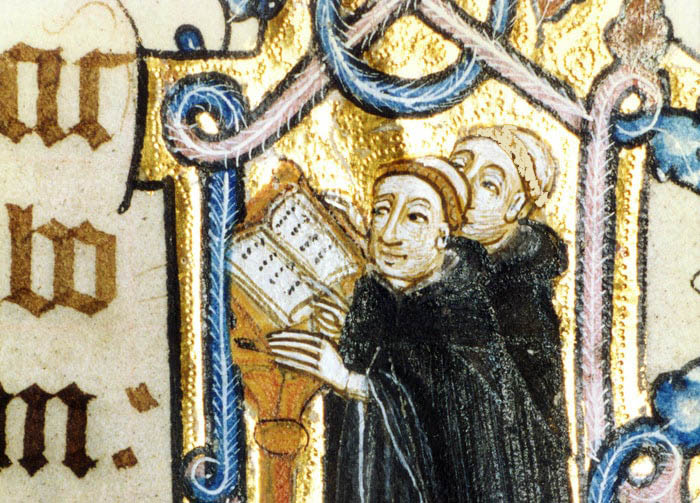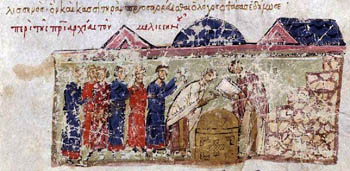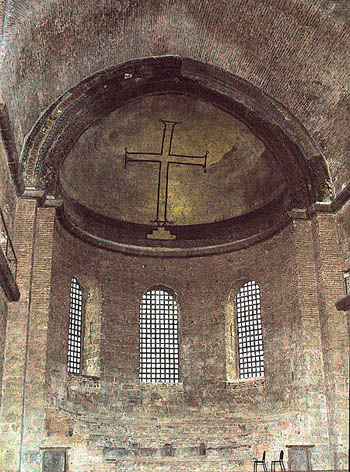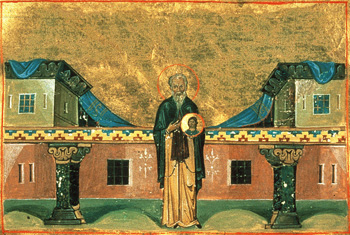Saints of the Day
 |
 |
 |
 |
 |
 |
 |
St. Nicetas, Abbot - April 3
Biographical selection:
St. Nicetas was born in Bithynia in 761 of a pious family. His father, who felt called to leave the world after the death of his wife, sent him to be raised in a monastery where great austerities were practiced. The youth readily imitated the models of virtue he had before his eyes. Prayer and the reading of the Scriptures were his occupations.
 Knowing the holiness of the young monk, the Abbot St. Nicephoros entrusted to him the government of the monastery when he became ill and named him as his successor. After the death of St. Nicephorus, Nicetas governed the monastery, showing that he possessed the virtues that the position required.
Knowing the holiness of the young monk, the Abbot St. Nicephoros entrusted to him the government of the monastery when he became ill and named him as his successor. After the death of St. Nicephorus, Nicetas governed the monastery, showing that he possessed the virtues that the position required.
But the Devil determined to disturb the peace of the Saint. The instrument he used was the Emperor Leo V the Armenian, who followed the Iconoclast heresy and in 813 waged a war against the holy images. This Sovereign cruelly persecuted the Catholics and placed in the See of Constantinople an official of his court, the heretical layman Theodosius, who had neither capacity nor virtue.
During these years Nicetas strongly defended the Church doctrine. When he refused to accept the heresy, he – along with other Bishops and Abbots who followed his example – were thrown into prison and endured numerous other sufferings.
The Emperor's representative, seeing that he could not make them betray their faith, attempted a trick: He proposed that they need only communicate one time from the Patriarch Theodosius. Then, they could leave prison and return to their dioceses and monasteries.
All except Nicetas immediately fell into the trap. But the other Prelates entreated him to accept as well, since they could not go and leave him alone in prison. They argued: What is being asked from us is nothing; let us concede a little in order not to lose everything.
Under the pressure of the elder Prelates, Nicetas made the concession. They went to an oratory where the icons where still conserved and they took Communion from the hands of Theodosius. The latter then placed an anathema on anyone who would venerate images other than the image of Christ.
After he returned to his monastery, however, Abbot Nicetas saw that the persecution against icons was continuing. Then, he repented of his deed, returned to Constantinople and fearlessly denounced the Iconoclast heresy. He firmly declared that he would not abandon the faith of his fathers nor recognize the authority of Theodosius as Patriarch.
Many magnificent promises were made to him, but he would not change his position. Consequently, he was sent in exile to the extremities of Anatolia [Turkey today] where he was locked up for six years in a horrible prison.
He made penance until the end of his life for the concession he had made. When the successor of Leo the Armenian halted the persecution, he did not return to his monastery or go to live in Constantinople. He went to a small hermitage close to that city and died there in 824.
Comments of Dr. Plinio:
You see what the challenge was. This Theodosius was a worthless man who had been placed in the Episcopal See of Constantinople. The Emperor, who had fallen into the Iconoclast heresy, forbade the cult of the images and began to persecute all the faithful Hierarchy and clergy.
 He imprisoned many of the Bishops and Abbots and offered to release them on the condition that they made a communicatio in sacris with Theodosius, that is, that they should receive the Blessed Sacrament from his hands and thus indirectly recognize him as a true Bishop. Most likely, Theodosius did not have the approval of the Pope and, therefore, did not have jurisdiction over Constantinople. Since he was a heretic, this is what probably the case.
He imprisoned many of the Bishops and Abbots and offered to release them on the condition that they made a communicatio in sacris with Theodosius, that is, that they should receive the Blessed Sacrament from his hands and thus indirectly recognize him as a true Bishop. Most likely, Theodosius did not have the approval of the Pope and, therefore, did not have jurisdiction over Constantinople. Since he was a heretic, this is what probably the case.
So then, the Emperor told them that if they would just receive Communion once from Theodosius, he would set them free.
So, Theodosius and the others went to a room where there were still images of Our Lord painted on the wall. Theodosius, who was against icons, nonetheless condescended to give Communion to the group in that room. He gave Communion to the group and then issued an anathema against any other painted image. After that he left.
 Thus the failthful Bishops were taken in by the tactic, "concede a little to not lose all," The Bishops reasoned: "Let us make one small concession to leave prison and to not lose everything." Abbot Nicetas, who unfortunately also fell into this trap, later made penance for this action for the rest of his life.
Thus the failthful Bishops were taken in by the tactic, "concede a little to not lose all," The Bishops reasoned: "Let us make one small concession to leave prison and to not lose everything." Abbot Nicetas, who unfortunately also fell into this trap, later made penance for this action for the rest of his life.
The mania to always agree with others and the horror of being in disagreement are things that can lead even persons of great virtue to actions that they later will deplore. On that occasion the Abbot was a man of virtue, but he was not yet a saint.
You see how the heretics of all epochs are crafty. When they encounter resistance, they always ask for the same thing: "Concede just a little…" St. Nicetas made penance until the end of his days for the concession he had made. His penance is a good lesson for us.
I wish Our Lady would give us the grace of never falling into one of these situations where, because of fear to suffer hatred or ostracism, we concede a little to not lose everything. Few things are more diabolical than the maxim: "Concede a little to not lose all."


The Saint of the Day features highlights from the lives of saints based on comments made by the late Prof. Plinio Corrêa de Oliveira. Following the example of St. John Bosco who used to make similar talks for the boys of his College, each evening it was Prof. Plinio’s custom to make a short commentary on the lives of the next day’s saint in a meeting for youth in order to encourage them in the practice of virtue and love for the Catholic Church. TIA thought that its readers could profit from these valuable commentaries.
The texts of both the biographical data and the comments come from personal notes taken by Atila S. Guimarães from 1964 to 1995. Given the fact that the source is a personal notebook, it is possible that at times the biographic notes transcribed here will not rigorously follow the original text read by Prof. Plinio. The commentaries have also been adapted and translated for TIA’s site.
St. Nicetas was born in Bithynia in 761 of a pious family. His father, who felt called to leave the world after the death of his wife, sent him to be raised in a monastery where great austerities were practiced. The youth readily imitated the models of virtue he had before his eyes. Prayer and the reading of the Scriptures were his occupations.

The young monk Nicetas was a worthy disciple of the old Abbot, St Nicephorus
But the Devil determined to disturb the peace of the Saint. The instrument he used was the Emperor Leo V the Armenian, who followed the Iconoclast heresy and in 813 waged a war against the holy images. This Sovereign cruelly persecuted the Catholics and placed in the See of Constantinople an official of his court, the heretical layman Theodosius, who had neither capacity nor virtue.
During these years Nicetas strongly defended the Church doctrine. When he refused to accept the heresy, he – along with other Bishops and Abbots who followed his example – were thrown into prison and endured numerous other sufferings.
The Emperor's representative, seeing that he could not make them betray their faith, attempted a trick: He proposed that they need only communicate one time from the Patriarch Theodosius. Then, they could leave prison and return to their dioceses and monasteries.
All except Nicetas immediately fell into the trap. But the other Prelates entreated him to accept as well, since they could not go and leave him alone in prison. They argued: What is being asked from us is nothing; let us concede a little in order not to lose everything.

St Nicetas repented & made penance
for the rest of his life
After he returned to his monastery, however, Abbot Nicetas saw that the persecution against icons was continuing. Then, he repented of his deed, returned to Constantinople and fearlessly denounced the Iconoclast heresy. He firmly declared that he would not abandon the faith of his fathers nor recognize the authority of Theodosius as Patriarch.
Many magnificent promises were made to him, but he would not change his position. Consequently, he was sent in exile to the extremities of Anatolia [Turkey today] where he was locked up for six years in a horrible prison.
He made penance until the end of his life for the concession he had made. When the successor of Leo the Armenian halted the persecution, he did not return to his monastery or go to live in Constantinople. He went to a small hermitage close to that city and died there in 824.
Comments of Dr. Plinio:
You see what the challenge was. This Theodosius was a worthless man who had been placed in the Episcopal See of Constantinople. The Emperor, who had fallen into the Iconoclast heresy, forbade the cult of the images and began to persecute all the faithful Hierarchy and clergy.

Emperor Leo V consecrated the iconoclast Theodosius as Bishop of Constantinople
So then, the Emperor told them that if they would just receive Communion once from Theodosius, he would set them free.
So, Theodosius and the others went to a room where there were still images of Our Lord painted on the wall. Theodosius, who was against icons, nonetheless condescended to give Communion to the group in that room. He gave Communion to the group and then issued an anathema against any other painted image. After that he left.

Iconoclast church decor:
everything destroyed but the cross
The mania to always agree with others and the horror of being in disagreement are things that can lead even persons of great virtue to actions that they later will deplore. On that occasion the Abbot was a man of virtue, but he was not yet a saint.
You see how the heretics of all epochs are crafty. When they encounter resistance, they always ask for the same thing: "Concede just a little…" St. Nicetas made penance until the end of his days for the concession he had made. His penance is a good lesson for us.
I wish Our Lady would give us the grace of never falling into one of these situations where, because of fear to suffer hatred or ostracism, we concede a little to not lose everything. Few things are more diabolical than the maxim: "Concede a little to not lose all."

 | |
|
|
The texts of both the biographical data and the comments come from personal notes taken by Atila S. Guimarães from 1964 to 1995. Given the fact that the source is a personal notebook, it is possible that at times the biographic notes transcribed here will not rigorously follow the original text read by Prof. Plinio. The commentaries have also been adapted and translated for TIA’s site.


